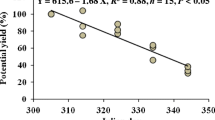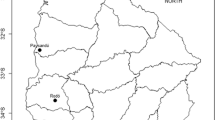Abstract
A simple model, G1 Blackspot Manager, has been developed to predict the seasonal pattern of release of ascospores in relation to ascochyta blight in field pea. The model considers a combination of two weather factors, daily mean temperature and daily total rainfall, to drive progress of maturity of pseudothecia on infested field pea stubble from past crops. Each day is categorised as suitable or not suitable for continuation of the maturation process. The onset of pseudothecial maturity has been found to take place when approximately ten suitable days have occurred. Following the onset of maturity, ascospore release is triggered when daily rainfall exceeds a threshold. The model was satisfactorily calibrated using three datasets from Western Australia. The calibrated model performed well when independently tested with 21 datasets, 17 from Western Australia and 4 from South Australia. It is concluded that G1 Blackspot Manager model has the potential to be used to formulate sowing guides for field pea in southern Australia that minimise the risk of ascochyta blight.










Similar content being viewed by others

References
Bretag TW (1991) Epidemiology and control of ascochyta blight of field peas. PhD Thesis, La Trobe University, Australia
Bretag TW, Keane PJ, Price TV (1995) Effect of ascochyta blight on grain yield of field peas (Pisum sativum L.) grown in southern Australia. Aust J Exp Agric 35:531–536
Bretag TW, Keane PJ, Price TV (2000) Effect of sowing date on the severity of ascochyta blight in field peas (Pisum sativum L.) grown in Wimmera region of Victoria. Aust J Exp Agric 40:1113–1119
Bretag TW, Keane PJ, Price TV (2006) The epidemiology and control of ascochyta blight in field peas: a review. Aust J Agric Res 57:883–902
Chilvers MI, Rogers JD, Dugan FM, Stewart JE, Chen W, Peever T (2009) Didymella pisi sp. nov., the teleomorph of Ascochyta pisi. Mycol Res 113:391–400
Davidson JA, Hartley D, Priest M, Herdina, Krysinska-Kaczmarek K, McKay A, Scott ES (2009) A new species of Phoma causes ascochyta blight symptoms of field peas (Pisum sativum) in South Australia. Mycologica 101:120–128
Gadoury DM, MacHardy WE (1982) A model to estimate the maturity of ascospores of Venturia inaequalis. Phytopathology 72:901–904
Galloway J, MacLeod WJ (2003) Didymella rabiei, the teleomorph of Ascochyta rabiei, found on chickpea stubble in Western Australia. Australasian Plant Pathol 32:127–128
Jeffrey SJ, Carter JO, Moodie KB, Beswick AR (2001) Using spatial interpolation to construct a comprehensive archive of Australian climate data. Environ Modell Softw 16:309–330
Kobayashi K, Salam MU (2000) Comparing simulated and measured values using mean squared deviation and its components. Agron J 92:345–352
McDonald GK, Peck D (2009) Effects of crop rotation, residue retention and sowing time on the incidence and survival of ascochyta blight and its effect on grain yield of field peas (Pisum sativum L.). Field Crops Res 111:11–21
McMurray LS, Davidson JA, Lines MD, Leonforte AL, Salam MU (2011) Combining management and breeding advances to improve field pea (Pisum sativum) grain yields under changing climatic conditions in south-eastern Australia. Euphytica. doi:10.1007/s10681-011-0362-9
Peever TL, Barve MT, Stone LJ, Kaiser WJ (2007) Evolutionary relationships among Ascochyta species infecting wild and cultivated hosts in legume tribes Cicereae and Vicieae. Mycologia 99:59–77
Salam MU, Khangura RK, Diggle AJ, Barbetti MJ (2003) Blackleg Sporacle: a model for predicting onset of pseudothecia maturity and seasonal ascospore showers in relation to blackleg of canola. Phytopathology 93:1073–1081
Salam MU, Galloway J, Payne P, MacLeod WJ, Diggle AJ (2006) Field pea blackspot disease in 2005: prediction versus reality. In 2006 ‘Lupins and Pulses Updates, Agribusiness Crop Updates 2006’. Department of Agriculture, Western Australia, South Perth WA, pp 91–93
Salam MU, Fitt BDL, Aubertot JN, Diggle AJ, Huang YJ, Barbetti MJ, Gladders P, Jedryczka M, Khangura RK, Wratten N, Fernando WGD, Penaud A, Pinochet X, Sivasithamparam K (2007) Two weather-based models for predicting onset of seasonal release of ascospores of Leptosphaeria maculans or L. biglobosa, causes of phoma stem canker of oilseed rape. Plant Pathol 56:412–423
Schoeny A, Jumel S, Rouault F, Le May C, Tivoli B (2007) Assessment of airborne primary inoculum availability and modelling of disease onset of ascochyta blight in field peas. Eur J Plant Pathol 119:87–97
Shtienberg D, Gamliel-Atinsky E, Retig B, Brener S, Dinoor A (2005) Significance of preventing primary infections by Didymella rabiei and development of a model to estimate the maturity of pseudothecia. Plant Dis 89:1027–1034
Stensvand A, Eikemo H, Gadoury DM, Seem RC (2005) Use of a rainfall frequency threshold to adjust a degree-day model of ascospore maturity of Venturia inaequalis. Plant Dis 89:198–202
Tivoli B, Banniza S (2007) Comparison of the epidemiology of ascochyta blights on grain legumes. Eur J Plant Pathol 119:59–76
Zhang JX, Fernando WGD, Xue AG (2004) Temporal and spatial dynamics of mycosphaerella blight (Mycosphaerella pinodes) in field pea. Can J Plant Pathol 26:522–532
Acknowledgements
We thank the Grains Research and Development Corporation (GRDC) of Australia for financial assistance in this work. Alan Harrod, Pip Payne and Tessa Humphreys of the Department of Agriculture and Food Western Australia provided technical assistance in data collection.
Author information
Authors and Affiliations
Corresponding author
Rights and permissions
About this article
Cite this article
Salam, M.U., Galloway, J., MacLeod, W.J. et al. G1 Blackspot Manager model predicts the maturity and release of ascospores in relation to ascochyta blight on field pea. Australasian Plant Pathol. 40, 621–631 (2011). https://doi.org/10.1007/s13313-011-0035-0
Received:
Accepted:
Published:
Issue Date:
DOI: https://doi.org/10.1007/s13313-011-0035-0



